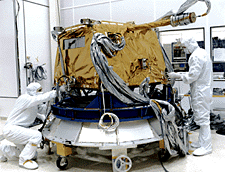
FUSE
NSSDC ID: 1999-035A
Description
FUSE (the Far Ultraviolet Spectroscopic Explorer) represented the next generation, high-orbit, ultraviolet space observatory covering the wavelength range of 90.5-119.5 nm. The primary objective of FUSE was to use high-resolution spectroscopy at far ultraviolet wavelengths to study the origin and evolution of the lightest elements (hydrogen and deuterium) created shortly after the Big Bang, and the forces and processes involved in the evolution of galaxies, stars and planetary systems. FUSE is a part of NASA's Origins program. The spacecraft was launched as a joint US-Canada-France project. Only one previous mission, Copernicus, has given us this far-ultraviolet region of the electromagnetic spectrum. However, FUSE will provide sensitivity some ten thousand times greater than Copernicus.
The FUSE satellite consists of two primary sections, the spacecraft and the science instrument. The spacecraft contains all of the elements necessary for powering and pointing the satellite, including the Attitude Control System, the solar panels, and communications electronics and antennas. The observatory is approximately 7.6 m long with a baffle fully deployed.
The FUSE science instrument consists of four coaligned telescope mirrors (~39 cm x 35 cm clear aperture) based on a Rowland circle design. The light from the four optical channels is dispersed by four spherical, aberration-corrected holographic diffraction gratings, and recorded by two delay-line microchannel plate detectors. Two channels with SiC coatings cover the range 90.5-110 nm and two channels with LiF coatings cover the range 100-119.5 nm. Actuators on the mirror mountings will keep the focus to 90% encircled energy within 1.5". A Fine Error Sensor (FES) with a 21' square field will maintain the spacecraft pointing stability to 0.5 arcseconds.
The FUSE observatory was designed for an operational lifetime of three years, although it was hoped that it might remain opertional for as long as ten years.
NASA since recommended an additional two-year extension beyond the prime mission. FUSE Science Operations were on hold from Dec. 10, 2001, to approximately the end of January 2002, due to a problem with the pointing system.
The last operational reaction wheel on FUSE stopped on 12 July 2007. Attempts to restart any of the reaction wheels were unsuccessful. Although the telescope itself remained in excellent condition, the satellite was incapable thereafter of the fine pointing control required to acquire useful science data and the mission was terminated.
Alternate Names
- Explorer 77
- Far-Ultraviolet Spectroscopic Explorer
- MIDEX/FUSE
- 25791
Facts in Brief
Launch Date: 1999-06-24
Launch Vehicle: Delta II 7320
Launch Site: Cape Canaveral, United States
Mass: 1400.0 kg
Nominal Power: 520.0 W
Funding Agencies
- Canadian Space Agency (Canada)
- NASA-Office of Space Science Applications (United States)
- Centre National d'Etudes Spatiales (France)
Discipline
- Astronomy
Additional Information
Questions or comments about this spacecraft can be directed to: Coordinated Request and User Support Office.
Personnel
| Name | Role | Original Affiliation | |
|---|---|---|---|
| Dr. George Sonneborn | Project Scientist | NASA Goddard Space Flight Center | sonneborn@stars.gsfc.nasa.gov |
| Dr. H. Warren Moos | Mission Principal Investigator | Johns Hopkins University | hwm@pha.jhu.edu |
US Active Archive for FUSE Information/Data
The FUSE Archive at MAST(STScI)
Other Sources of FUSE Information/Data
The FUSE Project at JHU

